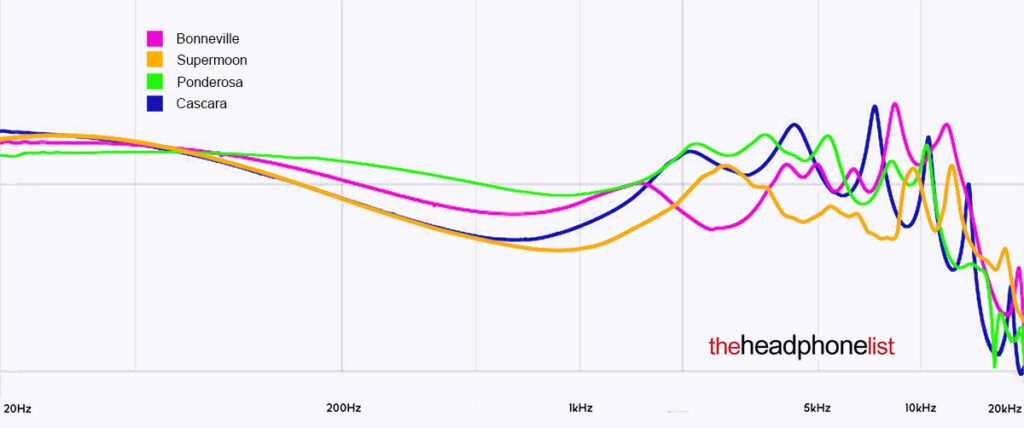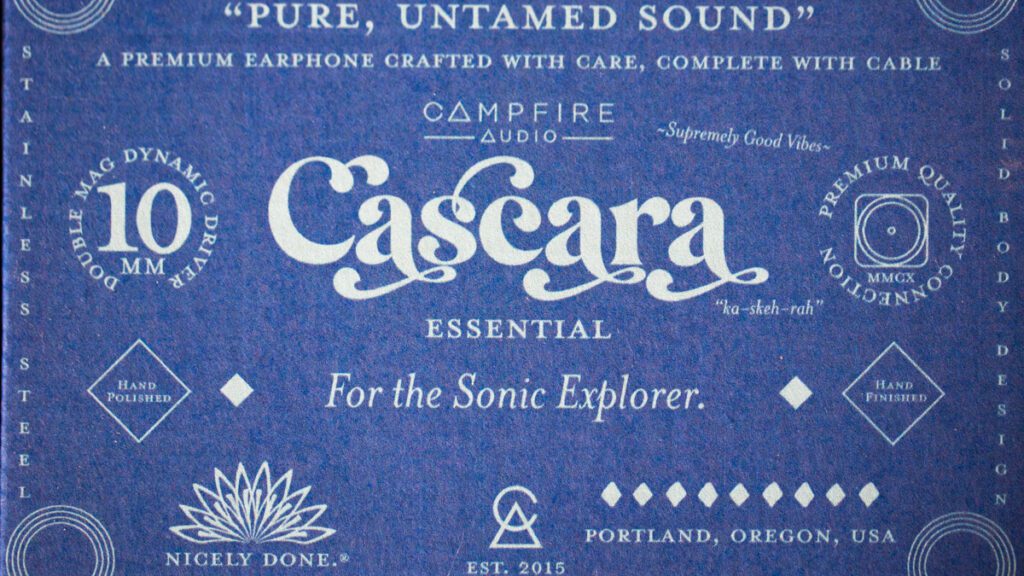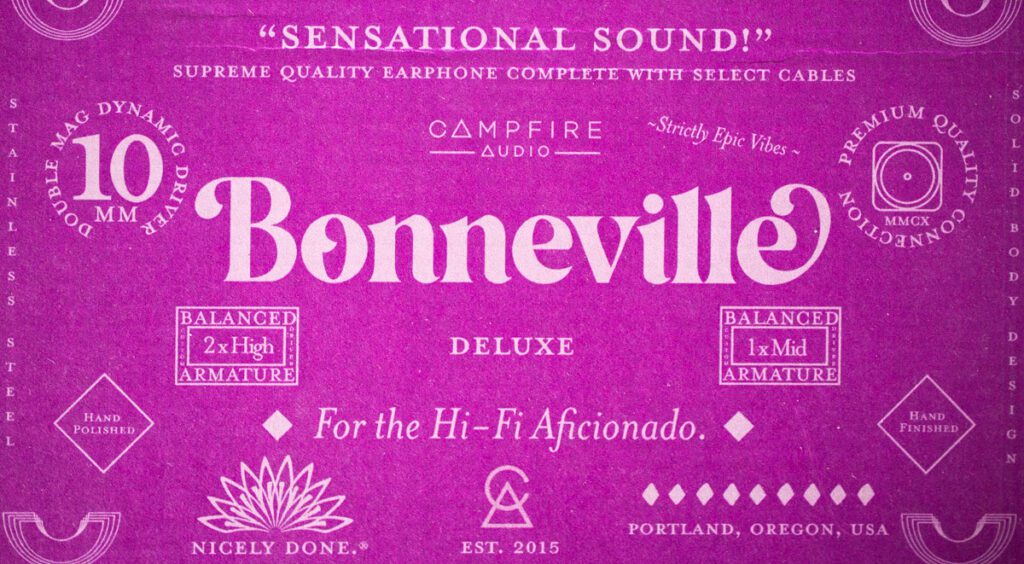Sound impressions
Since I already had Supermoon and Bonneville, I spent the last month getting more acquainted with Cascara and Ponderosa, before sitting down for several sessions of A/B/C/D comparisons to analyse all four IEMs relative to each other. I tested each IEM in turn with a selection of test tracks across a wide range of genres, making notes as I went along.
I’ve split the results in two: the generic sound impressions below, describing how I heard each IEM tonally and technically, and then, in the next section, comparing how the IEMs match up against each other across a selection of my favourite tracks. Between the two sections, you should get a fairly good idea of the relative strengths and weaknesses of each IEM, and which one (or more) best matches your personal preferences.
Below is a combined SPL graph of the four Chromatic IEMs, which will hopefully help with understanding their different properties I describe below, visually.

Cascara
Big and raw is how I would describe Cascara’s sound. Tonally this is a bass-first IEM, with unapologetically fat and rumbly sub-bass, and plenty of midbass heft and punch. Despite the size, the bass is generally well controlled, and while there is some slight bleed into the lower mids – which are relatively recessed by comparison – it’s not a bloaty bass per se. I put this down to Campfire’s new dual magnetic driver, which seems to perform quite well as a full range driver.
Despite the lower mid valley, the mids aren’t hidden behind the bass and treble per se. This is achieved with a fairly steep pinna gain round 2-3KHz, which dips slightly before bumping back up at 5KHz. Female vocals are very clearly articulated, and Campfire’s trademark vocal cleanliness is definitely on show here. It’s not a particularly wet or organic-sounding midrange though, so if that’s what you’re after, there are better choices elsewhere in the set.
I described Cascara as raw, and that’s because of how it renders treble. Not that I find treble uncontrolled, but a series of sharp peaks between 7KHz and 10KHz bring in a certain spice, especially with drier female vocals and some peaky cymbal splashes. This seems par for the course with Campfire, letting the treble run a little wild with a notable crispness compared to smoother control in the lower frequencies.
Tip and cable rolling will help with taming the treble peaks, so if you’re fatigued by the zing in stock form, as I sometimes am, try some narrower bore tips and a copper cable.
Technically, Cascara has some merit, although I must say I expected a bit more here given how well this driver is implemented in Bonneville. Resolution is nothing to write home about, and I feel that Cascara struggles a bit when it comes to playing busy or complex music passages to perfection.
Staging is also average, not too narrow but certainly not at the same level of the other Chromatics. Still, given its ‘modest’ price, I wouldn’t say that technical performance falls short of other IEMs I’ve heard in this tier, but you’re going to have to spend more if more refined technicalities are what you’re after.
Overall, I find Cascara the perfect example of Campfire’s house sound in a very accessible, cohesive-sounding, well-crafted package. It’s not going to win any technical awards compared to its pricier siblings, but it doesn’t embarrass itself either. Ideal as a daily driver for just enjoying your music with a full-on bass-driven sound that doesn’t shy away from spice.

Ponderosa
Where Cascara is big, bold and bassy, Ponderosa is gentler, more refined, with a smooth warmth that permeates across its mid-focused tonality.
Bass is very much subservient here; for anyone who’s heard Andromeda and its ‘meek’ bass, Ponderosa hits a little harder, but bass is still cast in a supporting role. There’s a certain quality here that I’ve come to expect from Campfire, and even though the BA bass drivers aren’t nearly as physical as their dynamic counterparts, they can still punch when required.
Midrange is where the stars align for Ponderosa. Unlike Cascara’s lower-midrange recession, Ponderosa is full and warm, the colouration from the bass shelf carrying across in an almost linear fashion through the mids. There’s plenty of detail here, though that’s probably because mids are thrust front and centre. It’s still a drier sound, favouring clarity over earthiness, but it’s also cushioned by the overall warmth of the tuning. There are no specific peaks in the midrange, so male and female vocals are rendered at a similar level, as are instrument fundamentals.
Treble is more subdued relative to Cascara’s zippiness, but that’s not to say the sound is dull or flat. Quite the opposite, there’s some sparkle here, with the trademark Campfire crispness, but unlike Cascara (or Supermoon) it doesn’t interrupt the class like an overactive child. There’s detail aplenty here, which makes it easier to hear finer sounds in the mix, especially since the bass is kept firmly in check.
As you can probably surmise, Ponderosa is a step up from Cascara technically, although it doesn’t quite reach the technical heights of Bonneville, and especially Supermoon. Resolution is very good, and there’s a much better sense of space, separation and layering than the single Cascara driver could muster.
It’s a cleaner sound too, with more blackness between notes, making them easier to hear and arrange on stage. I wouldn’t call this the most dynamic IEM I’ve heard, so it’s better suited to relaxed listening than high-energy head banging.
Overall, Ponderosa is typically Campfire for those who equate Campfire’s sound to Andromeda. The two IEMs share more than a few similarities, not least the green colourway and five BA driver array (even if the drivers, crossovers and sound chamber designs are different). It’s a more accessible Andromeda for those who don’t want to spend over $1,000 on the ‘real thing’, but won’t impress those who don’t consider Andromeda anything special.

Supermoon
For the sake of this review I decided to listen to Supermoon afresh, and describe it specifically in the context of the other Chromatic IEMs. As such, it’s interesting how my feelings toward Supermoon’s sound have morphed over the time that I’ve had it.
Tonally, Supermoon is slightly V-shaped, with a forward but not over-emphasised bass, tuned more sub- than mid. It’s a tight, textured bass that extends all the way down into the single-digit frequencies, with a satisfyingly large but not overly-physical rumble. As with the other frequencies, the bass is fast and tight, with a rapid-fire decay that doesn’t lend the sound much if any warmth at all.
This crisp character extends into the mids, which open up like a landscape vista, exposing every fundamental nuance in a performance. Mids aren’t particularly forward, but they’re rendered with such clarity and sharpness that it’s unlikely you’ll miss anything, even in bass-heavy or treble-dominant tracks. That said, this is an unforgivingly dry sound, with an upper-midrange peak that exposes the higher octaves of female vocals beyond what I consider comfortable.
With the right material, vocals are intoxicating, but with lesser recordings they can sound thin and metallic. That said, drums, guitars and strings are absolutely on point, and still among the best I’ve heard in IEM format.
Some of Supermoon’s vocal midrange timbre issues can probably be traced back to its mid-to-upper treble peaks, which can be both fatiguing and strident if they hit wrong. However, put on some clean, punchy EDM or large classical and orchestral performances, and the treble tuning makes perfect sense.
Technically, if you’re a fan of planar headphones – specifically the crisp-sounding, highly-resolving speed monsters produced by the likes of Hifiman – you’ll find much to like here. Technical performance has been Supermoon’s superpower from my very first listen, and I remember more than one heated debate with fellow enthusiasts when I claimed Supermoon was the most resolving IEM I’d heard bar none.
While I’ve tempered that opinion slightly (probably because I’ve since been exposed to even more resolving IEMs), I still consider Supermoon’s resolution, holographically-deep staging, and exceptional imaging to be world-class, right up there with those of far more expensive IEMs. The one area where Supermoon lags is dynamics, offering a flatter ‘always-on’ sound that’s characteristic of planar drivers in general.
Overall, while Supermoon has lost its place among my personal favourite IEMs, it still represents the pinnacle of planar sound in IEM form, in my opinion. It’s a clean, hyper-detailed, coolish sound, bordering on analytical, with timbre that won’t impress vocal purists. But damn, it renders so pristinely, that with the right material it’s as good as endgame. It’s just a pity that performance level is so fleeting, although lovers of classical music will find it much more consistent.

Bonneville
If you’ve diligently read through my descriptions of the first three Chromatics, you’ve arrived at the point where they all converge. Bonneville is almost an aggregation of most of the strengths I’ve noted thus far in the other IEMs, with surprisingly few of their weaknesses. It’s the consummate all-rounder, blending power and boldness with speed and technical acuity.
Tonally, I find Bonneville to be the most balanced tuning of the lot, with a slight U-shaped curve that spotlights bass and treble but doesn’t leave the mids behind. Bass is punchy, with powerful rumble when called for, but not quite as bold or fat at Cascara’s. Where it eclipses Cascara is detail and texture, not quite Supermoon level, but more satisfyingly physical than Supermoon. This new Campfire dynamic driver is the real deal.
The warmth of the bass carries over into the lower mids, giving Bonneville a fuller sound than Cascara, reminiscent of Ponderosa in this regard. It’s not quite as transparent as Ponderosa though, so male vocals gain more chestiness and less nuance, while female vocals are free to soar. Timbre throughout is excellent, surpassing Supermoon and Ponderosa with its earthiness, although it still has the trademark Campfire crispness to it.
Treble is far less strident than Supermoon or Cascara, and won’t call unnecessary attention to itself unless the track regularly hits the customary Campfire middle-finger peak at 7KHz. This tuning adds some bite, and certainly adds sparkle when called for, but I find Bonneville’s bass balances it out nicely and doesn’t let it run roughshod over the music. Still, if there is a fly in this ointment, you’ll find it in Bonneville’s treble, and despite a much smoother sail, I still get the occasional zing or raw spike on certain tracks.
Technically, Bonneville is the star performer of the series, not because it’s better than Supermoon, but because I feel it strikes a better balance between its pleasing all-rounder tonality and technical acuity. It’s staging is the biggest of the lot, wider than Supermoon’s with similar depth, and it seems to wrap around the head more than its planar sibling. Resolution is also excellent, though not quite at Supermoon level, easily surpassing the other two Chromatics. Where Supermoon is less dynamic, Bonneville will get your feet tapping more often, although it’s equally adept at rendering slower, more sedate music for a relaxing session.
Overall, it makes sense why Bonneville was made the flagship, and why Supermoon was ’demoted’ to second fiddle. This is a better all-round IEM, and other than classical music purists, the one I’d recommend ahead of the others for anyone who cares about maximising sound quality.

Continue to sound impressions – track by track…



